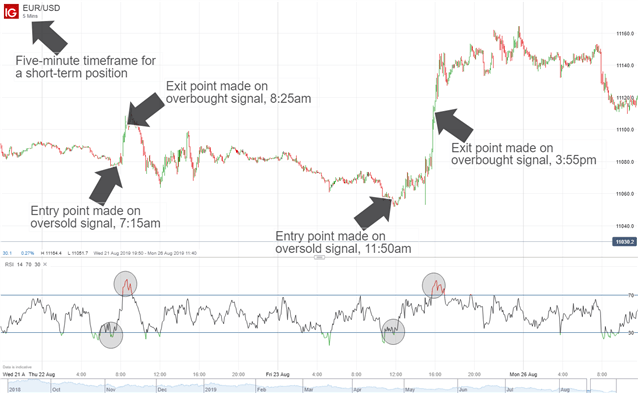There are many types of forex traders, and each demands a different approach. Whether you choose the fast-paced sprint of day trading or the prolonged marathon of position trading, selecting the right style for you will maximize your chance of success. Read on to learn more about the types of forex traders active in the world's largest market.
The six different forex trader types
Forex traders tend to fit into one of the following six trading types: scalper, day trader, swing trader, position trader, algorithmic trader, and event-driven trader. Read about the separate types below and discover the character traits that are optimal for each.
1. Scalper
Scalpers are short-term traders focusing on holding positions for timeframes as small as a few seconds to a few minutes. Forex scalping strategies involve trading frequently throughout the day, with the intention of achieving small gains at the busiest (most liquid) times.
Scalpers live life in the fast lane. Continuously faced with processing new information and reacting to rapid market changes, you’ll ideally be observant, instinctive and quick-witted – but stoical under pressure.
2. Day Trader
Day traders also execute frequent trades on an intraday timeframe. While their routine will not be as fast-paced as a scalper’s, day traders will similarly close all positions before the end of the trading day, so as not to hold any overnight. This means trades are not affected by negative news that can hit prices before the market opens or after it closes.
To be successful as a day trader, you’ll need to be ready to adapt to quick changes in price, as well as be cognizant of techniques important to this style of trading, such as fading the gap.
The below is an example of a five-minute chart used by scalpers and day traders, showing typical day trading entry and exit points. These points are based on Relative Strength Index (RSI) signals, with the oversold and overbought areas circled on the chart.

3. Swing Trader
Swing traders hold onto trades for longer than a single day, and up to perhaps a couple of weeks. Over this short timeframe, swing traders will typically favor technical analysis over fundamentals , although they should still be attuned to the news events that can trigger volatility.
This trader type is less frantic than scalpers and day traders, so extreme alertness is less of a requirement, but you’ll still requires a strong eye for detail when it comes to chart analysis. Find out more on how to identify and trade market swings .
4. Position Trader
Position traders hold trades for longer periods of time, from several weeks to years. As the longest holding period among trading styles, position traders are less interested in an asset’s short-term price fluctuations and more concerned, naturally, with the performance over more sustained timeframes.
As a forex position trader , you will require patience as your money will often be locked up for long time periods. Particularly with longer-term trades, a thorough knowledge of fundamental factors is beneficial, so advanced analytical skills will serve you well.
Below is an example of a daily chart typically used by a position trader, showing a long position and an exit more than two months later, again based on RSI signals circled on the chart. While the timeframe is daily, position traders will also often scale down to shorter timeframes to pick trends.

5. Algorithmic Trader
Algorithmic traders rely on computer programs to place trades for them at the best possible prices. Traders can use defined instructions, or high-frequency trading algorithms , to either code the programs themselves, or purchase existing products.
This type of trading suits people who are comfortable with using technology and want to apply it in their forex career. Given the nature of the programs, algorithmic traders will also have a keen eye for the technical charts.
6. Event-driven Trader
Event-driven traders look to fundamental analysis over technical charts to inform their decisions. They’ll seek to benefit from spikes caused by political or economic events, such as Non-Farm Payroll data, GDP , employment figures, and elections.
This type of trading will suit a person who likes to keep up with world news, and who will understand how events can impact markets. Inquisitive, curious and forward-thinking, you will be skilled at processing new information and predicting how global and localized events may play out.
The chart below shows how Non-Farm Payroll can provide an opportunity for an event-driven trader, using the common strategy of entering long when the price breaks above the trendline of a pullback.

Different types of forex trader summarized
| Forex Trader Type | Time in Trade | Personality Traits |
|---|---|---|
| Scalper & Day Trader | 1 min-1 day | Observant, Instinctive, Quick Witted |
| Swing Trader | 2-6 days | Calm, Selective, Focused |
| Position Trader | Weeks-Months | Patient, Systematic, Strategic |
| Algorithmic Trader | All Timeframes | Tech-savvy, Technical, Mathematical |
| Event-driven Trader | All Timeframes | Inquisitive, Analytical, Forward-Thinking |
Can you change your forex trading style?
No forex trading style need be static and there is every possibility yours can change. You may be a scalper stressed by short-term price action and seeking the free time found in position trading. Or, you could be a technical swing trader who wants to learn more about the fundamentals of the events-driven approach.
Whatever your style or goals, there is always a way to grow and develop, and test your skill on the markets in new ways.
Further reading to decode your trader type
For more information on identifying your ideal trading style , as well as how to manage the ups and downs of forex trading, take a look at the following:
- Top forex trading strategies every trader should know
- How to keep a forex trading journal and set trading goals
- Need a forex trading refresher? Download our New to Forex guide .

